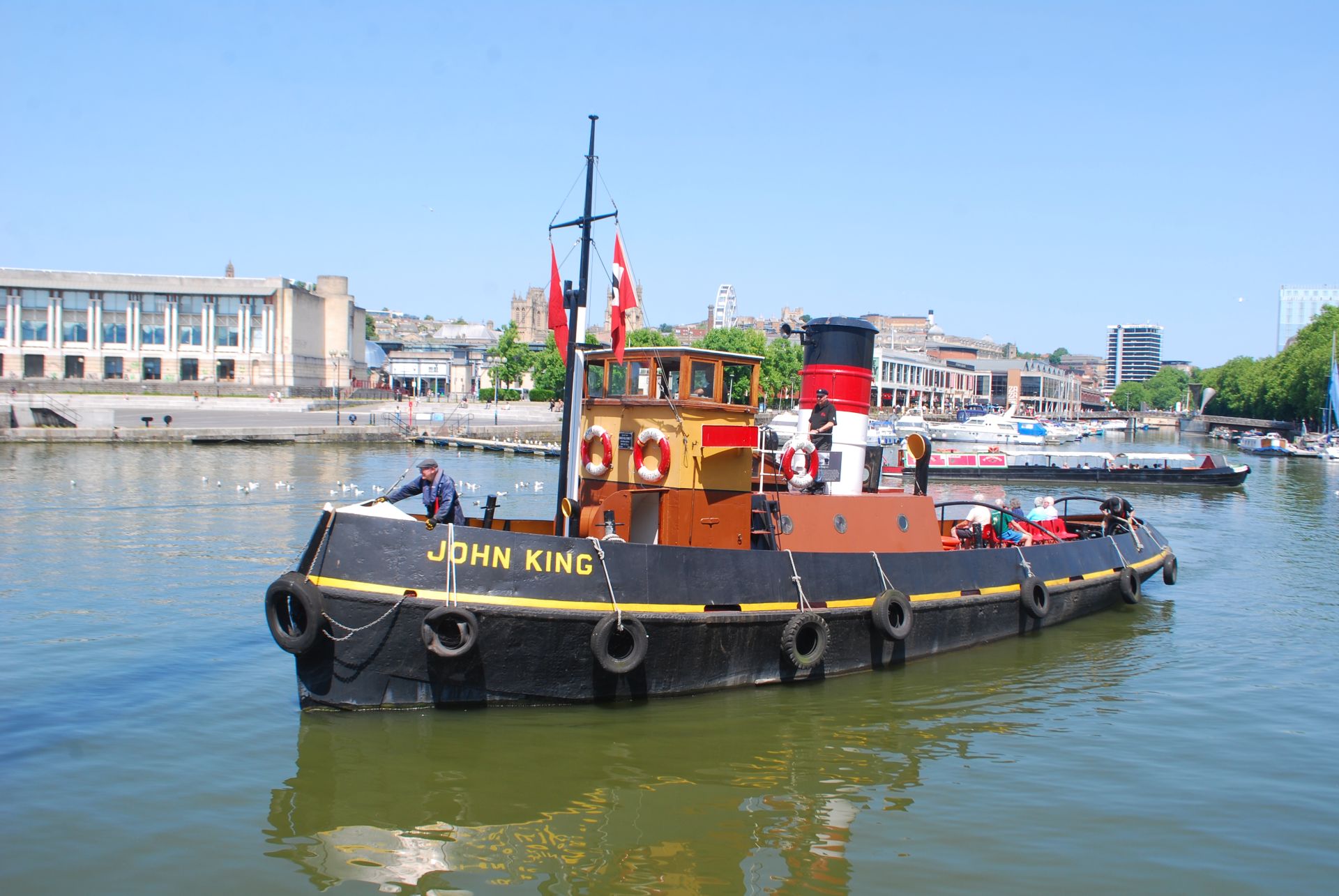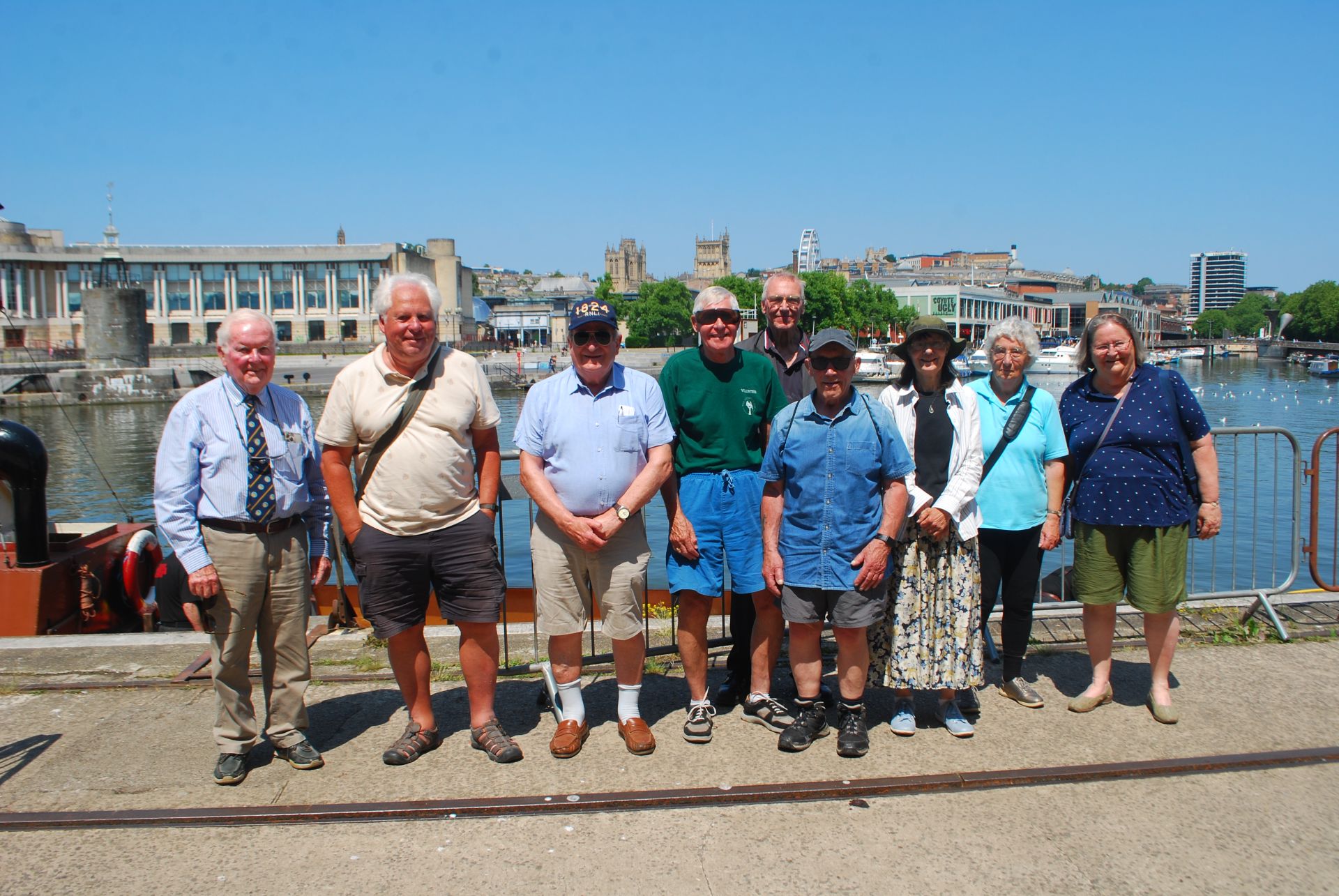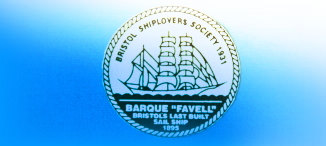|

PLEASANT MEMORIES
Our much missed, dear friends Peggy and Geoff Williams enjoying lunch with Nigel Edgell during the Society's Trip to Bideford to visit the Freshspring in 2017. Geoff was our effervescent and vastly knowledgeable Vice President whose infectious enthusiasm spanned all modes of transport.
RECENT OUTINGS
Visit to the SS Great Britain.
17th July 2025

Report :Visit to the Great Britain
By Rosemary Brown
Twelve of us enjoyed a very interesting and informative visit to the Great Britain led by Maurice. He told us that the Great Britain stands today where it was built and was completed in 1843, designed by Isambard Kingdom Brunel. It returned to Bristol in 1970.
It was made of iron and had a propellor unlike most other ships which were built of wood and had side paddle wheels and was the first transatlantic liner. Sails were fitted as well which would be useful on long journeys. Later the propellor could be lifted by a mechanism out of the water.
There is a glass layer around the Great Britain with water on it to represent the sea. The sealed unit allows humidity to be controlled to the hull. The main mast was made of steel and was recovered from the Falkland Islands -it had been left in the Falklands when the ship carried coal from Wales to San Franciso and was returned to Bristol.
During it’s working life, the Great Britain acted as a luxury liner, an emigration ship to Australia which took 65 days and also carried troops to the Crimean War and Indian Mutiny.
‘Boarding cards’ of people who travelled on the ship giving information about them from diaries were available to look at.
As a luxury liner it carried 250 passengers and 130 crew but later when emigrants were carried there were 800.
On the top deck the ship had 6 masts whereas most ships had 3-4. They were swivel masts. There were skylights to let in the light. Steering was at the stern to control the rudder.
In the engine room where there was a steam engine which still works we could imagine how hot and noisy it would be and speaking tubes were provided because of the noise.
Sound effects gave us an idea of the fresh food on board-live cows, sheep pigs and geese/chickens.
First class passengers were at the back of the ship and steerage in the front. We visited the steerage area where passengers could have tea and coffee but no milk or sugar and biscuits which were very hard and dry and often full of bugs and people soaked them in their drinks in order to be able to eat them. They could bring their own food in. No toilets or basins were provided in steerage-they used chamber pots or buckets and used cold salt water to wash. We saw the bunk beds that they slept in.
We then visited the galley/kitchen which included a bakery for the first class passengers . Rats were prevalent on the ship and there were cats to help catch them. First class passengers had toilets, basins and baths. We were shown a ‘ladies/girls sitting area’ where there was carpet on the floor and maids helped them with their dresses. The Promenade deck had first class cabins either side and most passengers promenaded here rather than out on deck.
We also saw the surgeon’s cabin and the Captains’s cabin and day cabin.The dining room for first class passengers had imitation marble and a lot of gold coluring and the menu had 54 items.
The back of their seats could be moved so that they could watch the entertainment following their meal.
We had to leave then but the rest of the group went to visit the dry dock.
Our tickets last for 12 months so we will be able to revisit the Great Britain as there is such a lot of detail to look at.
Many thanks to Roger for organising the visit and Maurice for his knowledge and explanation.
Day at the Docks 2025
19th June 2025

Twelve members enjoyed another extremely pleasant " Day at the Docks"
As has been customary, during the morning we embarked on the preserved tug John King for leisurely cruises along the Docks to Cumberland Basin and back.

This was followed up by the opportunity to operate one of the Dock Cranes under close safety supervision.
After lunch, the members were afforded the chance to peruse the fascinating M- Shed reserve collection.
Once again, a tremendous day out. Many thanks to the staff and volunteers at M-Shed.

A group of members after the morning session.
Visit to the RNLI at Poole
12th September 2024
Visit Report – by David Verghese
17 Society members gathered at our RBL venue in Whitchurch for what turned out to be a most interesting and worthwhile visit to the RNLI College and lifeboat manufacturing/maintenance facilities at Poole. The Society had undertaken a trip to Poole back in 2015 but our itinerary then , which included a boat trip past Brownsea Island and on to Swanage steam railway, bypassed the RNLI facilities which were observed from the boat.
The following year our summer excursion took us to the lifeboat station at Minehead where we had an excellent intro to their ‘D’ class lifeboat. Thus this trip had the promise of filling in gaps of the wider RNLI and Poole itself.
We hooked up again with our old friends from Centurion Coaches and, in very fine weather, driver Steve safely steered us along the confines of the A39, the A 37 and a subsequent detour into the Poole RNLI HQ where we tucked into a very nice lunch, optionally topped up by local Dorset brews from the Slipway bar.

The RNLI College, picture courtesy RNLI
Splitting up into two groups we then embarked on an interesting tour of the site, each led by a volunteer guide. Basic info gleaned over the tour, in this the 200th anniversary since the RNLI first formed and dedicated itself to saving lives at sea, included:
- Over 9,000 lifeboat crew, mainly volunteers, including those on shore – 11,000 are women
- 238 lifeboat stations including 37 in the Republic of Ireland
- Services also include international assistance, lifeguards on beaches and flood rescue
- It is reckoned that 143,00 souls have been rescued over the 200 years
- About 135,000 volunteers in all support full-time staff
- Running costs amount to about £500,000 per day to support all of the above
- Charitable donations fund the RNLI - about 64% of their income derives from legacies in people’s wills; there is no income from Government.

A view from the 2nd floor of the college – photo credit David V.

Another view outside with a lifeboat alongside– photo credit DV
Our first port of call on the tour was to visit and observe a sea survival course in the large pool equipped with a powerful wave machine where we saw two instructors supervising three trainees in capsize training and self-righting mechanics. The five in full rescue gear disappeared into an air pocket of the upturned boat before restoring the rightful status quo of boat. This skilfully mimicked a typical rescue at sea.

Sea survival training: photo credit – Nigel Edgell
A real highlight of the visit was our session in the all-weather Severn class lifeboat simulator. Two fully manned RNLI lifeboats were called into action from Dover lifeboat station with Helmsman R. Francis and Helmswoman S. Edgell in the hot seats. A huge container ship had collided with a cargo vessel and both ships were on fire at the point of impact. We launched in a Force 5 wind and choppy sea and, as can happen in the English Channel, the weather suddenly deteriorated as a Force 8 rainstorm developed en-route to the stricken vessels. SAR helos and a RAF Hercules aircraft were in close contact with us and several Royal Navy vessels also closed in.

The simulated rescue situation
The scenario seemed quite realistic as the two lifeboats were tossed and turned in quite ferocious seas. With rescues successfully undertaken both lifeboats altered course for those famous white cliffs and we returned safely into Dover as calmer weather descended. The technology which must involve a series of video projectors playing computer generated imagery onto a wrap-around panoramic screen produced a ‘true to life’ experience which we found to be quite dramatic (who felt seasick?).
After viewing a video which highlighted some of the RNLI’s overseas’ work we then visited the boat build and service facility where a number of Shannon class lifeboats were under construction and some other classes of lifeboats were undergoing maintenance. Men of various skills and trades were busy and they were augmented by apprentices under training.

Photo credit – N.E.
At the end of the tour there was a chance to visit the RNLI shop before we boarded the coach back to Whitchurch
.
Our thanks to the Committee members and Lyn Jackson in particular for making this subsidised Society trip happen.
David Verghese
Chair of Bristol ‘Shipwreckers’ Gosport Outstation.
PS: Gosport Lifeboat Station is a volunteer-operated station located in Stokes Bay at the tip of Gosport peninsula. Owned and operated by Gosport and Fareham Inshore Rescue Service (GAFIRS), it operates free lifeboat services in the Solent from Portsmouth harbour to Titchfield Haven, on the approaching shores of Southampton Water. I often walk past it & observe it.
|
 |



